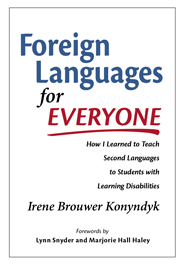The modified foreign language program is taught at Calvin College in a three-course sequence which takes one year to complete (fall semester, January term, and spring semester). It is ideal if students can have the same professor for all three courses – a master teacher who is patient, innovative, knowledgeable about learning disabilities, and willing to work hard. This gives students a safe environment in which they feel free to risk making errors in order to learn (a crucial element for foreign language learning) because they don’t have to get used to a new teacher each semester.
Students don’t have to provide evidence of a documented learning disability, but they do all need to demonstrate a history of prior foreign language failure / struggle, or explain why they have never attempted a foreign language (usually because a parent or school official advised against it).
Prospective students must go through a fairly rigorous process. Some have been referred to our learning disabilities office because they’re struggling in a current foreign language class. This office handles the initial steps, collecting any documentation, as well as doing initial intake and further testing. All students must take the Modern Language Aptitude Test (MLAT). Students take the long version which takes just over an hour. It looks at five areas: Number Learning, Phonetic Script, Spelling Clues, Words in Sentences, and Paired Associates. Sections I and II focus on phonology; Section III tests semantics; Section IV examines syntax; and Section V looks at rote memory. I can look at the five subtests within this test to try to better understand the area in which my students have deficits. Many of my students score in the fifth to tenth percentiles.
In the spring semester of each year I receive paperwork on each potential candidate for admission. It includes their MLAT results; a transcript of their college courses which includes their current GPA and academic status; their SAT/ACT scores; and their major(s). After examining their transcripts for prior foreign language attempts and grades – including withdrawals from a foreign language course – I decide which students to interview. (A copy of the content of the interview is in appendix B on the website). Each interview takes approximately ten minutes. I complete all the interviews well in advance of spring advising, so that students know whether or not they have been admitted for fall semester. No incoming first-year students are admitted into the sequence because they first need a year to figure out how college works.
For the interview I prepare a large spreadsheet—this is crucial for me so that I can remember different things about different students. The spreadsheet lists students’ names and columns for their class level, major, GPA, MLAT percentiles, the nature of the services they receive from the learning disabilities office, and whether they need the course sequence in the coming year (some need to wait until a subsequent year due to other academic graduation requirements). I’m often amazed at how little aware students are of their learning needs and the accommodations for which they’re eligible and why. Some students don’t want to be labeled as having a learning disability or ADHD, and prefer to “gut it out” without any special treatment. While there’s something admirable about this, I do bring up the idea that if they had a broken leg, wouldn’t they put a cast on it? Thus, if they have ADHD, for example, wouldn’t it be OK to take a medication for this? Some students don’t like the negative side effects of certain medications and thus don’t take them.
While I’m talking with each student I carefully observe them and write down any unusual things I notice, such as chewed up fingernails or bottom lip (which may be a sign of an anxiety disorder), extreme fidgetiness (which could be an indication of ADHD), lack of eye contact (which might suggest a student with social awareness issues, or Asperger’s syndrome), etc. I give each student a copy of the course contract (see Appendix C), explaining that they will need to sign this on the first day of class, if admitted into the sequence. This is a little bit of “truth in advertising” – that learning a language is hard work, and this contract lays out my expectations. If they do work hard, however, they will succeed. I want students to understand the seriousness of their responsibility – each of the 15 precious slots per class must be used by students who are determined to complete the sequence, because I can’t add new students midway through.
On the back of the contract, I write out the basics of the instructional approach (“multisensory, structured, metacognitive”), as well as other specifics of credits and scheduling. I explain that I want to teach to students’ strengths and help them with any area of weakness. I then give the students an opportunity to ask me questions and ask if they think the pedagogical approach would be helpful to them.
I also explain the process for choosing a cohort of students for the coming year and how those who most need the sequence in order to graduate will be given priority. Each class is limited to fifteen students. The students will hear something from the learning disabilities office once all the interviews have been completed. I send a list of accepted students to this office and then the Registrar puts them into the time slot that best fits the rest of their schedule. I give students a fairly accurate assessment of what their likelihood is of getting into the sequence for the coming year and I keep a waiting list.
In the rare case where I believe that a student doesn’t need the modified foreign language sequence, I suggest s/he try a traditional foreign language class. I also communicate that to the learning disabilities office, in case they have some other information in their file that would indicate a student’s need for the sequence. Students for whom there is no room in the sequence are told that a slot might open up over the summer. I give each student a copy of the contract with my notes on it—as a reference to our discussion, and I encourage them to contact me, if they have any questions.
A few slots are kept open for those students who invariably “come out of the woodwork” during late spring and over the summer, because they have switched majors (e.g. from nursing or engineering), or are finally coming to grips with the realization that they indeed do have to complete a foreign language in order to graduate. I often end up interviewing some students over the summer and the last few slots generally do fill up.


